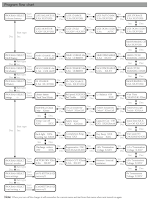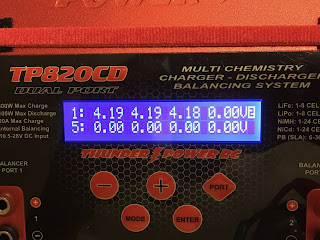Charsoon Antimatter Charger 250W 10A
Fast Links:
- For another version of this review, visit my blog
- For the official information and to buy visit: Bang good
A couple of two weeks later, a brand-new review unit arrived directly from China.
Opening the box we found the following:
- 22 page English manual,
- Male Dean-type connector charger cable.
- Combination J-Connector Futaba and BEC JST Female charger cable.
- XT-60 Connector charger cable.
- Alligator battery plugs with female banana connectors (to connect charger to a 12V battery)
- Charger unit
I liked the well written English manual.
The charger unit features:
- Built-in standard balance port board (no Thunderpower balance ports). It accommodates 2S to 5S batteries.
- Built-in fan.
- 4 multi-function buttons
- LCD screen
- Built-in input cables with male-banana input power (Input is 12V-18V).
- DC input jack (up to 18V 6A). This jack features self-resetting circuit breaker.
- A USB Port to connect to a computer. For configuration and to save and restore settings from a PC. Possibly firmware upgrades can be done via this port.
- My first impression is that the unit is well put together and is similar in form-factor to other units we've seen in the field. However there is a long list of features listed in the manual mainly promising easy of use and security
The Balance board is built in. This make the whole thing more compact.
The unit comes with ready-to-use alligator clips that can be attached to the input leads. These can be used to connect directly to a 12V battery.
Be aware that using these banana connectors produces a spark on the battery leads. Care must be taken to minimize this.
It is not clear if the internal electronics protect the charger from the sudden voltage surge.
The standard banana plugs can be used with a suitable power supply. Be mindful that input voltages cannot exceed 18V. This unit is not meant to be used with 24V power supplies.

Charge Test
I decided to use a small 12V battery instead of a power supply. When connecting to the battery there was a noticeable spark when connecting the alligator clips. The unit came up immediately. It is my expectation that the internal circuits will protect the charger from the voltage surge.
I found the menu system easy to navigate if you have the navigation flowchart next to you. Unless you are very familiar with this kind of charger clicking around may not be best way to find a specific function. For instance without the manual it would have been very hard to to find the "Preset Testing" mode (You have to press the STOP/BATT TYPE button for 3-seconds).


Battery Voltage 11.64 V
Internal Temperature 30º C
I used a 3S 2100 mAh LIPO battery as a test battery. This is battery must be charged at 1C. The balance connectors are standard JST and were plugged directly into the board on the side of the charger. The XT60 connector was plugged to the supplied charge lead. The charger itself was plugged a 12V battery for input power.
As a control device I used my trusty ThunderPower 820CD (a charger retailing for almost 3-times as much as the Antimatter Charger) connected to a high performance 24V power supply.
On the Antimatter Charger, I used the "Present Testing" mode to test the battery internal resistance and voltages. The batteries internal resistance was:


Anybody who has used any balancing charger should have no issues using this charger. A complete beginner is advised to read about charging LIPO batteries to understand the nomenclature and the procedures.
Warning: Typing the wrong mAh value could damage the battery.
The manual indicates there several sensors in the charger protect the device and the battery. There is a temperature sensor and other sensors stop charging if there is over voltage or excessive time has elapsed. All these parameters can be changed. I left all these values on the default.
33 minutes later a set of continues beeps announced that the battery was charged.

After the charge is complete we can check the voltages by putting the charger in "Present Testing" mode. During the charge is possible to switch between status and cell the voltages by pressing the [Dec] and [Inc] buttons.


Storage Test
I disconnected the Antimatter charger and was happy to confirm that the battery settings I had programmed were still there. There is no need to save the settings unless you plan to charge several kinds of batteries.
I setup the charge to discharge the battery to "storage" level.
The fan immediately came on as the battery is discharged
It took 36 minutes to discharge the battery to "storage level".

Again we compared the voltages



Special Battery Operations
- Charging and Preparing for Storage are the most common tasks users do with chargers.
- This charger however offers a few more programs:
- Charge in Unbalance Mode. (called in the manual Normal Charge Mode). This is definitely not recommended.
- Fast Charging. You can specify the maximum amps for fast charging. Care must be taken not to exceed the C-capacity of the battery when doing this. I personally never charge batteries at a rate higher than 1-C.
- Pre-Charging. This is a last-ditch effort mode to try to "resurrect" an otherwise dead battery. Some over-discharged batteries can be "revived" if pre-charged to a certain level before a normal balance charge. I would use this mode only as a last-ditch effort to salvage a battery. If the battery revives I would always keep it clearly marked and pay extra attention to it. I would check the internal resistance of the battery very often if a battery has been over discharged.
- Discharging. You can set a target voltage and discharge the battery to that level. I Personally have never used this mode on any charger unless I'm trying to test if a battery is healthy.
- Cycle battery. In this mode it is possible to discharge and charge a battery. This can be useful if you are testing a suspicious battery and want to make sure the battery behaves in a healthy manner.
- Monitor. You can monitor each batteries cells while the battery is being used. Note that this mode is not counting how many milliamps are being taken out of the battery. It just indicates under-voltage or over-voltage situations.
Special Operations
- Brushed motor mode. Brushed DC motors can be directly controlled by the charger. This can be useful in testing situations. Note that brushless DC motors cannot be controlled at all by this charger. I wouldn't plug an ESC directly to the charger either.
- Foam Cut. The charger can be used to provide power to a FOAM cutter.
I liked
- Price is very affordable, especially for a beginner.
- English manual written in good English.
- Built in balance board. Keeps things compact.
- Automatic selection of LIPO cell count depending on which balance port is being used.
- Fine-tuning of many parameters. For example you can control the minimum voltage to discharge a LIPO battery. As well many other parameters.
- Ready to use charge cables provided for different kinds of connectors.
I didn't like
- The volume for the key beeper is too loud for indoor use. One of the first things I did was to mute the key beeper.

- Connecting the charger to a 12V battery using the alligator clips will produce a spark. Hopefully the electronics inside the charger will protect the charger from the sudden voltage surge.
- Input voltage is limited to a maximum of 18V which means I cannot use a 24V heavy duty power supply I normally use on my other charger.
- Selecting one of the 10 memory is a bit cumbersome and error prone. You must change the charger mode to "PROGRAM SELECT/Save Settings" or "PROGRAM SELECT/Load Settings" and then select the memory location you intend to save-to or load-from. A small card will have to kept as a reminder of what is saved on each memory location. Other chargers show battery settings associated with each memory location so you don't have to remember that save location 07 contains the settings to charge a 3S 2100mAh LIPO.
- Saving saves a "battery set" which to me means that it will save the settings for charging a LIPO battery a PB battery a NiCD battery... all in one memory location. This is different from other chargers where a saved location is associated with one specific battery.
Vendor Information
- Vendor Web Site: http://www.charsoon.com/
- Bang good Page for this product: Bang good
